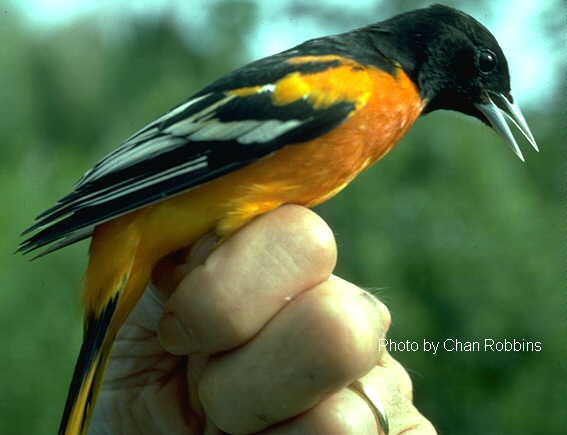A Knock at the Door
May 31, 2010
THE NORTHERN ORIOLE, also known as the Baltimore Oriole, is an unusual bird, as well as one of rare beauty. The male has distinctive bright orange and black plumage, party attire in a field of grays and browns in the woodlands of the Northeast. Perhaps this festive creature avoids being eaten by hawks by rarely alighting on the ground. It flits in the upper branches and dramatically swoops from one position to another as if on a trapeze. How else to explain the Oriole’s survival given his outrageous outfit?
The bird’s whistling, flute-like call is also distinctive and unmistakeable. We get very few Northern Orioles, but the ones we do get are easily identifiable from their perches in the woods. The whistle sounds human and they vocalize for many hours during the day.
My teenaged son and I have followed the Oriole’s habits for a few years and our amateur study of the bird is marked by both tragedy and uncommon bird-to-human communication.
A few years ago, we were standing in the kitchen talking about the arrival of an Oriole pair (the female is less brightly colored.) As we talked, there was a loud and insistent knock at the front door. I went to the glass door, but no one was there. Still I heard another knock. I looked down and saw something I have never seen in my life. A bird was knocking at the bottom of the door. It was an Oriole, rapping insistently with his beak, as if to say, “If you are going to talk about me, I’d like some input.”
This was a strange occurrence, perhaps a true miracle. In any event, it was so unlike any other in all my years of living alongside suburban woodland birds, who are usually aloof and incurious when it comes to humans, that I may report it to ecclesiastical authorities. For the next few days, the same bird continued to knock at the door and the windows. There was something inside he wanted, or something he wanted to say.
The next year, tragedy occurred. Orioles like to build pendant nests at the tip of high branches. These nests seem to dangle by the merest thread, further proof of the Oriole’s penchant for living dangerously. This year, a pair had built a nest right above our concrete walkway. A few feet further in any direction and all would have been fine. Instead, when a baby bird attempted to fly, he hit the sidewalk. He was instantly killed.
Just the other day, I was sitting outside when a female Oriole whizzed by, a few feet from my chair. As it happened, I was thinking of the Oriole at that precise moment. Orioles are mind readers. They play the flute and whistle to let us know our own thoughts.
— Comments —
Mabel LeBeau writes:
When my son and I visited his uncle and aunt in Vermont, it was quite a delicious and thrilling experience to hear the evening song of an unknown bird singing in their woods. It was a deep, almost slow melodic burble emanating, it sounded, as if from the deep bottom of a well. [Laura writes: That sounds like a thrush.] We are used to the song of a mourning doves in the evening, along with busy cicadas, and it was fun to identify the bird singing aurally from a computer program on the Internet.
The story of the knocking bird reminds me of a visitor we had for several Junes. We live on a ravine which, if followed leads to a city park below. Sometimes in winter deer come up the ravine and leave small hoofprints across the snow as they cross the backyards of our neighbors. Ducks, raccoons, and opossums also live in the ravine. A few years after we moved to this area of the country we heard the sound of something hitting our front window on a warm June day. For several days in a row, about the same time of the day, a beautiful golden finch dive-bombed the glass. In the interest of its safety, we drew the drapes, installed noisy chimes and used black shadow cut-outs of a horned owl to dissuade his infatuation. The last summer we saw it for a just a couple days and then one morning walking around the side of the house, its bright yellow-feathered lifeless body was lying on the side entrance stoop, dead-eyed. Perhaps, the neighborhood cat patrol attacked it and left it for dead. We often wondered where from and why it came to our window, alone, and where it was headed when it left, and if someone missed it when it didn’t ever appear again.
Laura writes:
Birds sometimes mistake glass for nothing and attempt to fly through it, but I’ve never known a bird to simply knock at glass. It’s amazing to me how rare the sight of a dead bird is given the number of birds there are.
Hannon writes:
Here is a very nice entry on the Hooded Oriole in San Diego.
It would be difficult for a non-birder with any awareness of nature to fail to notice orioles about. Being one of this group myself I don’t think I have seen them on more than one or two occasions. I remember a pair that nested in a fan palm, just as depicted in photos on the site linked here.
Looking on Wikipedia I found out that there are two groups of what we call orioles, one Old World and the other New World. They are not related in spite of striking similarities in appearance, habits, etc.
I wonder if these birds are common anywhere? Or were formerly more abundant? They seem to be poorly adapted to urban environments.

